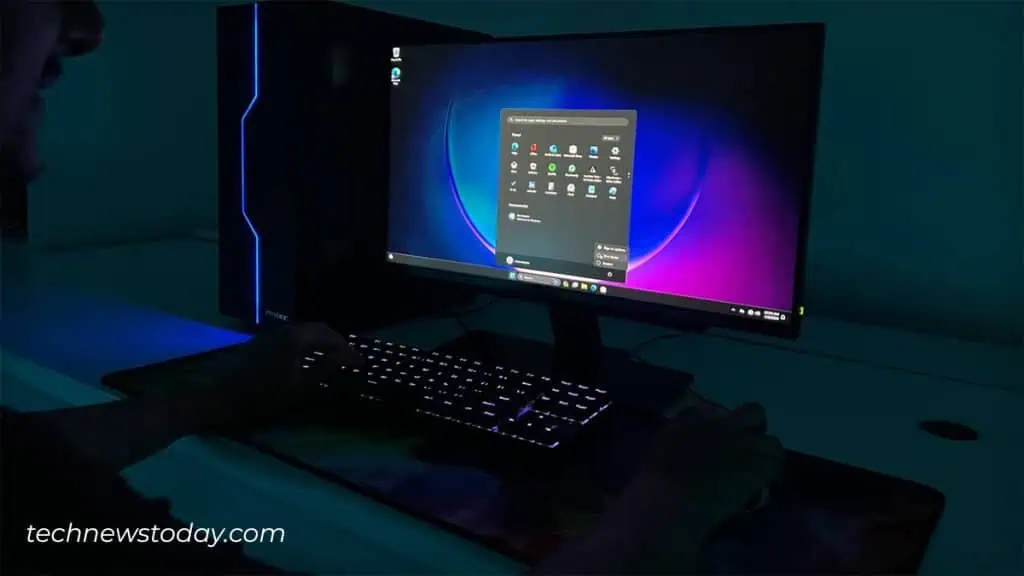Are you unknowingly making mistakes that could harm your computer or hinder your productivity?
In this article, we’ll cover 15 ways you might be using your computer wrong and show you how to fix them. Let’s dive in and start optimizing your computer usage!
Not Restarting Regularly

Many people simply put their computers to sleep or hibernate, which can lead to performance issues and software glitches over time.
When you don’t restart your computer regularly, memory leaks and background processes can accumulate, causing your system to slow down and become less responsive.
To keep your computer running smoothly, make a habit of restarting it at least once a week.
Restarting your computer clears out the memory, closes unnecessary background processes, and allows updates to install properly.
Ignoring Software Updates

Many users dismiss or postpone software updates, not realizing the potential consequences.
Neglecting updates can leave your computer vulnerable to security threats, as updates often include critical patches for known vulnerabilities.
Additionally, outdated software can cause compatibility issues and hinder the performance of your programs.
To stay protected and ensure optimal performance, enable automatic updates for your operating system and frequently used applications.
Cluttering Your Desktop

A common mistake many users make is saving all their files and shortcuts directly to the desktop.
While this might seem convenient, a cluttered desktop can actually slow down your computer.
When your desktop is filled with numerous files and folders, your computer has to load and display each item every time you boot up or switch between windows, consuming valuable resources.
To optimize your computer’s performance and improve file organization, create dedicated folders for your documents, pictures, and other files.
Utilize the built-in folders like Documents, Pictures, and Downloads to keep your files structured and easily accessible.
Reserve your desktop for only the most frequently used items, and regularly clean up any unnecessary files or shortcuts.
Not Using Keyboard Shortcuts

Many computer users rely solely on their mouse to navigate and perform tasks, not realizing how much time they can save by using keyboard shortcuts.
Constantly switching between the keyboard and mouse can be inefficient and disrupt your workflow.
Take some time to learn and practice essential keyboard shortcuts for your operating system and frequently used programs.
Shortcuts like copy (Ctrl+C), paste (Ctrl+V), and undo (Ctrl+Z) can significantly speed up your work.
Look for shortcuts specific to the applications you use most often, such as your web browser, email client, or productivity software.
Not Backing Up Your Data

One of the most critical mistakes computer users make is failing to regularly back up their important files and data.
Whether it’s due to hardware failure, theft, or ransomware attacks, data loss can be devastating and irreversible.
Protect your valuable files by implementing a robust backup strategy.
Use a combination of cloud storage services and external hard drives to create multiple copies of your data.
Automate your backups so that they run regularly without requiring manual intervention.
Neglecting Cable Management

A tangled mess of cables not only looks unsightly but can also lead to damage and poor airflow.
When cables are left unorganized, they can become bent, frayed, or disconnected, potentially causing malfunctions or even posing a fire hazard.
Additionally, a cluttered cable setup can hinder proper ventilation, causing your computer components to overheat.
Invest in cable management solutions like cable ties, sleeves, or raceway systems to keep your cords neat and tidy.
Route your cables in a way that minimizes clutter and prevents them from being stepped on or snagged.
Regularly inspect your cables for any signs of wear or damage, and replace them if necessary.
Overloading Your Browser with Tabs

Many users have a habit of keeping dozens of browser tabs open simultaneously, thinking it will help them multitask or quickly access information.
However, having too many tabs open can significantly strain your computer’s memory and processing power, leading to sluggish performance and potential crashes.
To optimize your browsing experience, be mindful of the number of tabs you keep open.
Close tabs that you no longer need, and use bookmarks or a read-it-later service to save pages for future reference.
Consider using browser extensions that suspend inactive tabs, freeing up valuable resources.
Not Reading Installation Options

When installing new software, many users hastily click through the installation wizard without carefully reading the options presented.
This can result in the unintentional installation of bundled adware, toolbars, or other unwanted programs that clutter your system and compromise your privacy.
Whenever you install new software, take the time to read through the installation options thoroughly.
Opt for the custom installation route instead of the default or express settings.
Be on the lookout for checkboxes or fine print that may give permission to install additional software or change your default settings.
If you’re unsure about an option, research it before proceeding.
Not Customizing the Start Menu

The Start Menu is a central hub for accessing your programs and files, but many users don’t take advantage of customization options.
A poorly organized Start Menu can make it difficult to find the apps and documents you need, wasting valuable time and causing frustration.
Take a few minutes to customize your Start Menu for optimal efficiency.
Pin your most frequently used applications to the Start Menu or taskbar for quick access.
Remove shortcuts for programs you rarely use to declutter the menu.
Organize your apps into logical groups or folders based on their purpose or frequency of use.
Never Removing Startup Apps

Over time, as you install more programs, your computer’s startup process can become bogged down by numerous applications that automatically launch when you boot up your system.
These startup apps consume valuable resources and can significantly slow down your computer’s loading time.
Regularly review and manage the programs that are set to run at startup.
Open your system’s startup manager (e.g., Task Manager in Windows or System Preferences in macOS) and disable any unnecessary apps that you don’t need running in the background.
Be cautious not to disable essential system processes or security software.
Re-Using Passwords or Using Weak Passwords

One of the most significant security risks is using the same password across multiple accounts or relying on weak, easily guessable passwords.
If one of your accounts is compromised, hackers can gain access to your other accounts that share the same password.
Weak passwords, such as “123456” or “password,” can be cracked in seconds, leaving your personal information vulnerable.
Adopt strong password practices to safeguard your online accounts.
Use a unique, complex password for each account, consisting of a mix of uppercase and lowercase letters, numbers, and symbols.
Avoid using easily guessable information like birthdays or pet names.
Consider using a reputable password manager to generate and securely store strong passwords for you.
Enable two-factor authentication whenever possible for an extra layer of security.
Connecting to Unsecured Public Wi-Fi

Public Wi-Fi networks, such as those found in cafes, airports, or libraries, are convenient but often lack proper security measures.
When you connect to an unsecured network, your data transmissions can be intercepted by malicious actors, putting your sensitive information, like login credentials or financial details, at risk.
Whenever possible, avoid connecting to unsecured public Wi-Fi networks.
If you must use public Wi-Fi, refrain from accessing sensitive sites or entering personal information.
Use a virtual private network (VPN) to encrypt your internet traffic and protect your data from prying eyes.
A reliable VPN creates a secure tunnel between your device and the internet, making it much harder for hackers to intercept your communications.
Not Cleaning Your Computer

Over time, dust and debris can accumulate inside your computer, clogging air vents and fans.
This buildup can lead to overheating, reduced performance, and even hardware damage.
Neglecting to clean your computer regularly can shorten its lifespan and cause unnecessary malfunctions.
Establish a regular cleaning routine for your computer.
Use compressed air to blow out dust from the vents, fans, and crevices.
Be gentle and avoid using vacuum cleaners, as they can generate static electricity and damage sensitive components.
For more thorough cleaning, consult your device’s manual or seek assistance from a professional.
Ignoring Error Messages

When faced with error messages or warning prompts, many users instinctively click “Dismiss” or “Ignore” without reading the content.
However, these messages often contain valuable information about potential issues or conflicts within your system.
By disregarding error messages, you may allow minor problems to escalate into more serious ones.
Take the time to read and understand error messages when they appear.
If the message is unclear or technical, research the specific error code or description online to gain more insight.
Addressing the underlying issues promptly can prevent further complications and keep your system running smoothly.
If you’re unsure about how to resolve an error, seek guidance from a knowledgeable friend, an online forum, or professional technical support.
Not Saving Work Frequently

It’s a scenario many of us have experienced: you’re working on an important document or project, and suddenly, your computer crashes, or the power goes out.
If you haven’t saved your work regularly, you risk losing hours of progress and effort.
Relying solely on autosave features can also be risky, as they may not capture your most recent changes.
Develop a habit of manually saving your work frequently, especially when working on critical projects.
Use the “Save” function in your applications regularly, such as after completing a significant portion of your task or before stepping away from your computer.
In addition to manual saving, enable autosave features in your programs and set them to save at shorter intervals.
Conclusion
By addressing these common mistakes and implementing the provided solutions, you can significantly improve your computer’s performance, enhance your security, and boost your productivity.
Start making these changes today and enjoy a smoother, more efficient computing experience.
Remember, small adjustments in your habits and practices can make a big difference in the long run.

